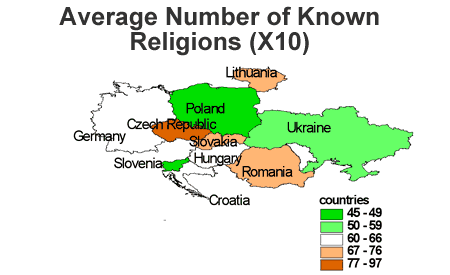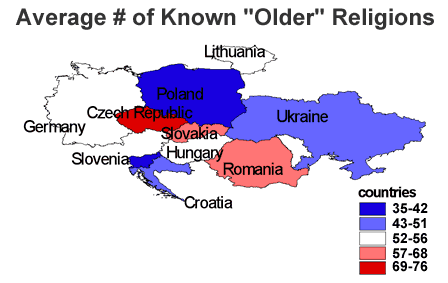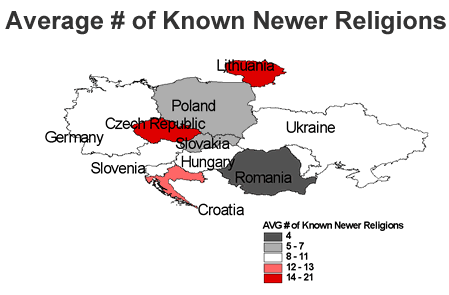The Familiarity of New Religious Movements in Central-Eastern Europe
by Peter Torok (University of Toronto)
Presentation at The 2001 International Conference, Spiritual Supermarket, April 20. Preliminary version)
In my presentation, I would like to share my findings on the familiarity of some new religious movements in Central-Eastern Europe. I think I found something interesting, but - at least for the time being – I am unable to come up with a proper explanation.
I hope that your questions and comments after my talk would shed more light on this phenomenon.
My research question was prompted by a news, more precisely by a belief, reported, among others, by Eileen Barker (2000), that the new religious movements launched a full-scale proselytizing offensive in the countries formerly under Soviet occupation.
Regardless of whether this belief can be substantiated by evidence, with the limited means available to me, I wanted to know:
- How well are the so-called new religious movements, supposedly proselytizing in this region, known in the former Communist countries? More precisely, how familiar are the people in Central-Eastern Europe with these movements?
A corollary curiosity was raised in me by interviews with the leaders of the registered religions in Hungary. In 1996/97, I contacted 48 out of the 55 non-historical registered churches. Six church leaders informed me that Hungary was a jumping off point for further missionary activities. Some of them supported this view not only with their words but also with institutional structures. The 7th Day Adventist Reform Movement opened its theological academy in a little Hungarian village partly because it was cheaper than in the West. Similarly, the leader of the International Church of Budapest is also the president of the Central European Bible Institute, a multidenominational school with students from all over the world. The Buddhists consider Hungary, more precisely the Carpathian Basin, especially sensitive to spiritualism[1]. It is, therefore, not accidental that the many recently established Christian and non-Christian denominations send missionaries from Hungary not only to the neighboring countries but also to Albania, Germany, and even the United States. Thus the same question, although with a special focus on Hungary, can again be raised:
- If Hungary is a jumping off position for further missionary activities, or if inhabitants of the Carpathian Basin are indeed highly sensitive to spirituality, does it manifest itself in the number of religions known by Hungarians?
I am sure we are all aware of the difficulties of defining religion and spirituality, but I hope you agree that a nation’s sensitivity to spirituality would manifest itself in the number of known religions, because a religion is an institutionalized form of a certain kind of spirituality.
The means of research available to me was the data set of the Aufbruch international project, organized by the Pastorales Forum at the University of Vienna. In this project the situation of religion was examined in ten former Communist countries: Croatia, Czech Republic, Germany, Hungary, Lithuania, Poland, Romania, Slovakia, Slovenia, and Ukraine. One part of the research was a survey, conducted in all of these countries in 1997-98. The sample of the survey, involving all together more than ten thousand persons (10309), was representative for age, sex, education and dwelling place. One of the questions asked was how many religions the respondent knew. Unlike in the Gallup surveys, conducted for instance in Hungary in 1997?, the interviewees were not presented with any list or card; in other words, they answered freely, on their own, without any help. This method will undoubtedly produce a response with a smaller number of religious organizations, but it measures more reliably the respondent’s active knowledge of religions.
From the data set, I compiled the following numbers.
Table 1. Different Indicators of the Familiarity of Religions in Central-Eastern Europe
|
Country |
Avg. # of Known Religions 1 |
Avg. # of Known “Older” Religions 2. |
Avg. # of Known “Newer” Religions 3 |
3/1 |
% Knowing Islam |
% Knowing Buddhism |
% Knowing KRSHNA Movement |
% Knowing Scientology |
% Knowing Unification Church |
|
Croatia |
6.3 |
5.1 |
1.3 |
0.21 |
63 |
23 |
34 |
3 |
2 |
|
Czech Rep. |
9.7 |
7.6 |
2.0 |
0.21 |
43 |
45 |
33 |
14 |
12 |
|
Germany |
6.6 |
5.4 |
1.1 |
0.16 |
28 |
26 |
7 |
48 |
4 |
|
Hungary |
6.5 |
5.5 |
1.0 |
0.15 |
22 |
27 |
32 |
2 |
1 |
|
Lithuania |
7.6 |
5.6 |
2.1 |
0.28 |
58 |
48 |
57 |
1 |
8 |
|
Poland |
4.9 |
4.2 |
0.6 |
0.12 |
14 |
14 |
18 |
1 |
2 |
|
Slovakia |
7.3 |
6.7 |
0.7 |
0.10 |
28 |
26 |
9 |
3 |
4 |
|
Slovenia |
4.5 |
3.5 |
1.0 |
0.22 |
49 |
14 |
32 |
4 |
1 |
|
Romania |
7.3 |
6.8 |
0.4 |
0.05 |
22 |
16 |
3 |
2 |
2 |
|
Ukraine |
5.9 |
5.1 |
0.9 |
0.15 |
29 |
27 |
28 |
1 |
2 |
Explanation/ Legend
2: The so-called older or historical faiths or religions consisted of the Catholic Church, including Greek and Armenian Catholics, the Old Catholics, the different orthodox churches, the Protestants, the Lutherans, the Calvinists, and the Jewish faith. The Adventists, Baptists, the Salvation Army, the Hussites, Methodists, Mormons, the New Apostolic Church, Pentecostals, Unitarians and the Jehova Witnesses were later grouped into the category of traditional sects. However, in this table they are under the category of “older” religions, because they do not belong to the NRMs by any categorization.
3: The newer religions included Islam, Buddhism, KRSHNA Movement, Scientology, the Unification Church, and other religious movements, if any other was mentioned.
Instead of going through the numbers here in the table, I used a GIS program, ArcView 3.1, to represent the different data. On the first map, we can see the average total number of known religions in each country. From the colors, we can learn that the Polish people and the Slovenians know the least number of religions, while the Czechs mentioned the highest number of religions. Lithuanians, Romanians and Slovakians are coming after the Czechs.
On the second map, the average number of known “older” religions are represented. From the colors we can see that similarly to the total number of known religions, the Polish people and the Slovenians mentioned the smallest number of historical religions, and the Czechs could name the most. The third map displays the number of known new religions in the region. The picture is somewhat different, insofar the Romanians named the least number of newer religions, although the Polish people are in the second last category. The picture also differs from the previous maps in that not only the Czechs but also the Lithuanians are placed in the category of people knowing the most number of newer religions. For all of these maps, the GIS program used natural breaks to classify and categorize the countries. We would have ended up with a slightly different categorization had the program used quantile[2], equal interval[3], or standard deviation[4] methods.
With the maps, we have seen the rank order of the countries, from which we can establish that the Polish people and Slovenians know the least number of religions, while the Czechs and Lithuanians mentioned the most number of churches. But the rank order does not say anything about the proportion of the old and newer religions. Let us return to the table (INSERT TABLE), where I highlighted in each column with red color the two highest and with yellow the two lowest values. In the fifth column, the proportion of newer religions can be seen, when compared to the average total number of known religions. It becomes clear that Lithuanians are the most knowledgeable about new religions, not only in terms of absolute numbers but also in terms of proportional knowledge. Slovakia has the second highest proportion of known new religions, but they mentioned much less religions than the Czechs. The lowest proportion of known new religions is unquestionably in Romania. Romanians’ knowledge about older religions is about the same as that of Slovakians, but the Romanians could name only half as much newer religions as their Slovakian counterparts.
Analyzing the proportion of known new religions individually in the different countries, we can see that Lithuanians are four times among the first two countries with the highest proportion of people knowing a given religion. The Czechs are the second, because they are three times among the first two countries. The Polish people and the Romanians are the least knowledgeable about new religions. Although both Romanians and Slovenians were twice among the last two countries with the lowest proportion of people knowing a given religion, I decided to pick Romania, because here the proportion of new religions was much lower.
With the preceding analysis, I can give an answer to my first question: How well known are the so-called new religious movements in the former Communist countries? We can say that in the so-called most knowledgeable countries, roughly half of the population know actively, i.e. they mentioned those new religious movements that are, or related to one or another, world religion: Islam, Buddhism or Hinduism, in the case of the KRSHNA movement. However, in the so-called least knowledgeable countries, i.e. the last two countries, only one in five, or one in seven persons knew these “newer” religions. With regard to the really new religious movements, Scientology and the Unification Church, which do not have a long historical background, the proportion of population knowing them is rather low. Only in the so-called most knowledgeable countries was the proportion of persons mentioning these religions around or higher than ten percent.[5] In sum, the new religious movements, especially the really new ones, were not very well known in the former Communist countries at the end of the century.
With regard to my second question, whether Hungarians are spiritually really sensitive, in terms of knowing new religious movements, we can say that contrary to the claims of religious leaders, the knowledge of Hungarians about new religious movements is rather mediocre. A profane, but probably a much more reliable explanation of the church leaders’ favorable opinion about Hungary might be the country’s geographic location and its ethnic connections with the neighboring states.
Finally, I would like to mention the intriguing problem. One could fairly easily explain why Romanians and Polish people are the least knowledgeable about new religious movements. Traditional religiosity and the dominance of established religions are still high in these countries[6]. One might also explain the Czech’s exceptional knowledge of older and newer religions with the nation’s relatively liberal attitude and high level of modernity. Although I have certain problems with this explanation[7], I do not want to discuss them here. The real question for me, what I cannot properly answer now, is the following: Why are the Lithuanians the ones who mentioned the highest number of newer religions?
I thank you for your attention; and I am looking forward to your questions and comments.
PICTURES
[1] Interview with Istvan Brecz-Gruber, the manager of the Karma Decsen Ozel Ling Buddhist community.
[2] In this classification method, each class is assigned the same number of features, i.e. countries.
[3] Here the subranges are equal.
[4] The program finds the mean value and then places class breaks above and below the mean at intervals of either 1, 0.5, or 0.25 standard deviations, until all the data values are included in a class.
[5] The great proportion of Germans mentioning Scientology can be explained by the legal processes that made high publicity to the church.
[6] C.f. Tomka, M.-Zulehner, Paul M.: Religion im gesellschaftlichen Kontext Ost(Mittel) Europas. Wien, 2000, Schwabenverlag; and Tomka, M.-Zulehner, Paul M.: Religion in den Reformländern Ost(Mittel)Europas. Wien, 1999, Schwabenverlag.
[7] In many respects, Hungarians are just as liberal and modern as the Czechs are. Religious tolerance cannot be the explanation either. Hungarians, Transilvanyans are proud of their Torda Treaty. In 1568, the Torda Treaty – today’s Turda in Rumania – was the first European declaration of the equality of religions and of guaranteed free religious practice.
|
The Spiritual Supermarket: Religious Pluralism in the 21st Century April 19-22, 2001 |
|
 |
|
[Home Page] [Cos'è il CESNUR] [Biblioteca del CESNUR] [Testi e documenti] [Libri] [Convegni]
[Home Page] [About CESNUR] [CESNUR Library] [Texts & Documents] [Book Reviews] [Conferences]


